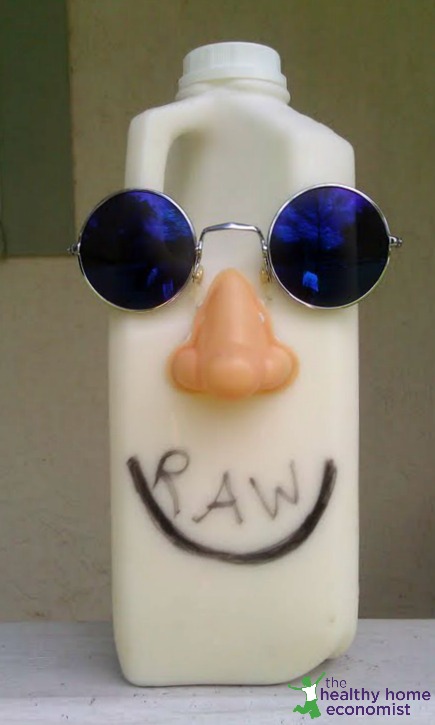 When folks start getting into Traditional Cooking, learning to ferment foods like clabbered milk is a basic skill that must be mastered. Lacto-fermented foods are rich in enzymes as well as beneficial bacteria.
When folks start getting into Traditional Cooking, learning to ferment foods like clabbered milk is a basic skill that must be mastered. Lacto-fermented foods are rich in enzymes as well as beneficial bacteria.
Think of lacto-fermented foods like clabbered milk, sauerkraut or pickles as “super-raw” foods. The enzymes in lacto-fermented foods more than compensate for the enzymes lost in the foods that are cooked when consumed with a meal.
Lactic acid is what is responsible for the magic of lacto-fermentation; it preserves food by inhibiting putrefying bacteria. This organic acid is produced by a beneficial bacterium present on the surface of all plants and animals – even our own skin!
Traditional cuisines from around the world prized lacto-fermented foods and beverages for their medicinal properties as well as delicious taste. Most traditional cuisines included at least one fermented food or beverage with every meal, which worked to improve digestion and nutrient absorption.
Why Clabbered Milk is Important
When embarking on the adventure of lacto-fermentation for the first time, a basic ingredient required by many recipes is liquid whey.
Liquid whey serves as an inoculant and so is of critical value in fermenting vegetables, fruit chutneys and beverages; having some on hand is of primarily importance when incorporating these traditional methods into your routine.
Whey must be homemade and can be easily made by straining the clear liquid from plain yogurt, kefir, or clabbered raw milk through a dishtowel into a bowl. Powdered whey cannot be used as a substitute as whey is very fragile and its qualities are ruined when it is dried or powdered.
Once you’ve got a big jar of liquid whey ready to go from your first batch of clabbered milk, the world of fermenting food is truly your oyster! The whey lasts 6 months in the refrigerator, so it makes sense to make large batches at a time.
You can also make delicious beverages with your clabbered milk. Try a milk clabber smoothie, or a sweet lassi, India’s delicious yogurt-style drink.
I’ve Left the Raw Milk on the Counter for a Week and it Won’t Clabber!
If after following the recipe below, your the raw milk still does not clabber, it’s time to have a conversation with your dairy farmer.
There is likely an issue with the Milk Urea Nitrogen value (MUN), which probably measures 23 or over. A high MUN prevents the raw milk from fermenting into yogurt or even clabbering properly. Cream from high MUN milk will not whip properly either.
This article on evaluating a grassfed dairy farm provides more information.

Homemade Clabbered Milk Recipe
Recipe for making clabbered milk at home which can be used for making homemade fermented foods and drinks loaded with enzymes and probiotics. Makes a great substitute for yogurt in smoothies too.
Ingredients
- 1 quart raw milk preferably grassfed
- 1 Tbl whole milk yogurt optional
- 3 drops lemon juice optional
Instructions
-
Add optional yogurt OR lemon juice to milk container if you need clabbered milk as quickly as possible. Skip this step if your milk is already sour or you are not in a hurry.
-
Shake up milk container vigorously.
-
Leave on the counter for 1-5 days until yogurt like curds form and separate from the clear liquid (whey) portion of the milk. How long this will take depends on the temperature in your home as well as the freshness of the milk. Here in Florida, clabbering typically takes 1-2 days no matter the time of year.
Recipe Notes
When attempting to clabber milk, it is best to use raw milk that is a week old or more. Keep it at room temperature on the kitchen counter and don't try to clabber in the refrigerator.
If your raw milk is very fresh and you don't have time to wait the many days until it clabbers, add the optional a few drops of lemon juice or a tablespoon of yogurt to the container of milk and shake it up. Leave on the counter as usual and it will clabber much more quickly.
NEVER attempt to clabber pasteurized milk even if low temp (vat) pasteurized. It will go putrid if left on the counter and is never safe to consume.
More Information
Sarah, The Healthy Home Economist








Can you make clabber milk from butter milk?
No … it’s already fermented.
I am making the homemade formula for my 6 month old. I bought raw milk and I am trying to clabber it in a mason jar to get whey. Is that okay to do? I know on your video you show a plastic gallon but was wondering if a mason jar would still keep all the properties and keep the clabber safe.
Help!
Thanks
A mason jar is fine.
Did anyone ever determine what causes bitter buttermilk? Is it safe to use? I just do not want to toss mine as it was expensive to make. 🙁
It couldn’t be easier. It’s like raw yogurt.
Quick question. Probably the same as many already on here. I had half of a gallon of raw milk that was a week old Friday. I poured half of a quart jar of the milk, set it on it’s side on the kitchen counter Friday afternoon (around 2:00pm). Saturday came and went and it hadn’t clobbered. I opened it to check and smell Saturday afternoon. Sunday morning, before church, around 9:00am, it had obviously clabbered and separated. At this time, I put it in a new, clean ( only washed with Original tide, no bleach, no softener, two rinses) white kitchen towel and hung it from a wooden spoon from my kitchen cabinet handles. It drained from 9:30am to 2:00pm. Everything looked great, but when I tasted the cream and whey and they had a bit of an off-putting taste. Maybe like others explained – bitter? I was SO excited to smear it on a bagel, but now I’m not sure i want to eat it. I’m afraid the whey won’t be good, either or will mold when I ferment veggies. Did I do something wrong? Thanks in advance!
I’m trying to figure out if my clabbered milk came out right (or at least safe to consume). It has a strong yeasty (fermented) taste…is that normal? And, is there a way to prevent that for next time? Thanks for your time.
It IS safe to consume.
Hello.
I have not opened my FIRST quart bottle of raw milk, which was good until–March 16 !
Today-May 31 st. Can I still use it as clabbered milk ? This is new to me . I have consistently
been eating-store bought feta & goat cheese & organic butter, but milk is a new one for me.Any advice & suggestions are welcome . Also , I would love a simple method for cheese as an alternative to the pasteurised feta & goat I buy.
Thanks,
Mark
Mark, I am not familiar with “truly” raw milk having an expiry date. Maybe its because I live in Gerogia where milk straight from the cow (raw milk) is illegal (eeeer government control) for human consumption so it’s all labeled for “Pets Only” but totally intended for humans. Anyway, if your milk is truly raw then yes it is still good. Research it, raw milk never goes bad! I’ve had several different batches of raw milk in my refrigerator for over 4 months that has curdled and still safe to consume. We do not drink it but I do use it in cooking. Only pasteurized milk “rots” NOT raw milk. What I would do with it would be make cultured butter from the cream that has formed on top and save the rest of it to use in cooking over the months to come.
To answer your second question: there are simple methods of making soft cheeses like the ones you mentioned so you’ll need to do your research for the methods. I would like to suggest getting Sally Fallon’s book called “Nourishing Traditions;” for it answers many questions about traditional foods and is an interesting and easy read. It is the food bible for us Weston A Prices followers. Also another good book on Traditional foods (albeit mostly on Lacto-Fermented foods) is “The Art of Fermentation” by Sandor Katz.. Good Luck!
Help, I am new to the raw milk, but mine tastes like a barn and I can’t bring myself to drink it. It this normal or should i try to find a different source? Also after three days of drinking the milk my three year old has a fever of 104 could this be from the milk, he is the only one in the family that doesnt mind the taste, so he has been drinking about 1.5 cups a day.
Need some help thanks!,
Can you extract whey from raw cows milk when the cream has already been removed to make butter? I have 3/4 of a gallon of this raw skim milk sitting out for 4 days. I saw it separate a little but when I poured it into a tea towel to separate the whey from the raw skim milk it mixed back together. I did get some cream cheese (left over milk solids) in my tea towel though. Thank you, BevAnn
Hi Sarah,
I found your website about a month ago and enjoy all the information you have on a traditional diet. I’m gathering a lot of information and would like to start with fermenting sauerkraut, but I need whey and I would like to make a lot of whey since it seems to be a main ingredient to many traditional recipes. My only problem is that I’m finding it hard to find raw milk. Places in my areas don’t seem to have Raw milk now and they wont for awhile. The only thing I found at Whole Foods is Organic Grass-Fed Unhomogenized whole milk by Sky Top Farms. Once I bought it I noticed in fine print that it is Grade A Pasteurized Cow’s Milk. I don’t think I could use pasteurized milk to get whey. Can you clarify this for me.
Thanks
Fatima